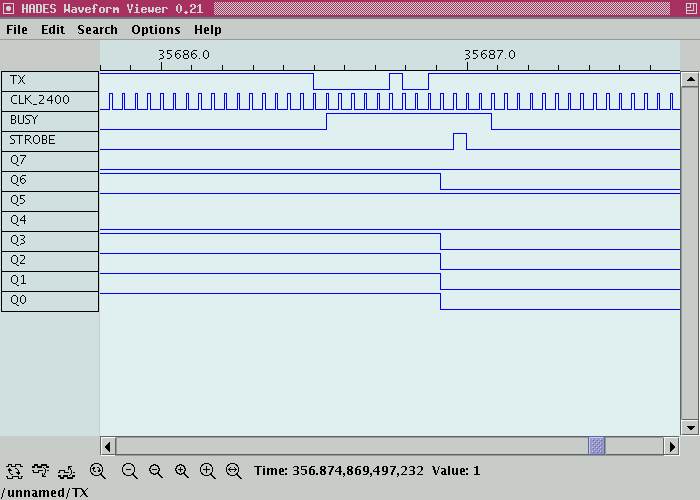

Applets
contents
visual index
 introduction
introduction std_logic_1164
std_logic_1164 gatelevel circuits
gatelevel circuits delay models
delay models flipflops
flipflops adders and arithm...
adders and arithm... counters
counters LFSR and selftest
LFSR and selftest memories
memories programmable logic
programmable logic state-machine editor
state-machine editor misc. demos
misc. demos
 LED sign
LED sign
 RS232 transm...
RS232 transm...
 RS232 transm...
RS232 transm...
 controller
controller
 shift-register
shift-register
 input-buffer
input-buffer 
 RS232 receiv...
RS232 receiv...
 RS232 receiver
RS232 receiver
 controller
controller
 shift-register
shift-register
 output-buffer
output-buffer 
 FSK modem
FSK modem
 FSK modulator
FSK modulator I/O and displays
I/O and displays DCF-77 clock
DCF-77 clock relays (switch-le...
relays (switch-le... CMOS circuits (sw...
CMOS circuits (sw... RTLIB logic
RTLIB logic RTLIB registers
RTLIB registers Prima processor
Prima processor D*CORE
D*CORE MicroJava
MicroJava Pic16 cosimulation
Pic16 cosimulation Mips R3000 cosimu...
Mips R3000 cosimu... Intel MCS4 (i4004)
Intel MCS4 (i4004) image processing ...
image processing ... [Sch04] Codeumsetzer
[Sch04] Codeumsetzer [Sch04] Addierer
[Sch04] Addierer [Sch04] Flipflops
[Sch04] Flipflops [Sch04] Schaltwerke
[Sch04] Schaltwerke [Sch04] RALU, Min...
[Sch04] RALU, Min... [Fer05] State-Mac...
[Fer05] State-Mac... [Fer05] PIC16F84/...
[Fer05] PIC16F84/... [Fer05] Miscellan...
[Fer05] Miscellan... [Fer05] Femtojava
[Fer05] Femtojava FreeTTS
FreeTTSThe circuit shown here consists of a serial terminal component which generates the serial RS-232 data, the actual receiver subdesign for the serial-to-parallel conversion, and a 'parallel terminal' (similar to a printer port but with on-screen output). The counters are just for visualization, because the repainting will be much to slow to follow the serial communication data, despite the comparatively slow baud-rate of 1200 baud.
When the applet is first loaded, it will open two extra windows, one for each of the terminals. Whenever you type into the 'serial terminal' window, the terminal will output the corresponding ASCII data on its TX output port. (You can change the communication parameters of the terminal via its 'configure' dialog. The default values used in this applet are 1200 baud, 8 data bits, parity bit, and 2 stopbits.)
The default of an idle RS-232 line is high. The receiver subdesign detects the start-bit that preceeds the data bits of each RS-232 character. It is clocked with the baud-rate, and clocks one bit per clock period into an 8-bit shift-register. Once all data bits have been read, the data is read-out from the shift-register and transferred to an output-buffer register, which in turn drives the parallel data outputs of the receiver. A short strobe pulse on the strobe output signals that a new character has arrived.
To show or hide the terminal windows, simply click on the terminal symbols in the schematics editor. On Windows systems you may have to shuffle the browser and terminal windows around, so that you can type characters into the serial terminal while still watching the main schematics window and the parallel terminal. Unfortunately, some web-browsers still have bugs with the handling of keyboard focus for Java applets. If necessary, bring the 'serial terminal' window into the front and try a mouse-click into the window to guarantee that the window has the keyboard focus, before you start typing into the window.
For a screenshot of the transmitter demonstration with both terminal windows open, click here
The following image shows an example waveform while receiving the input data (D0..D7) = (00000100), corresponding to the ASCII space char:
